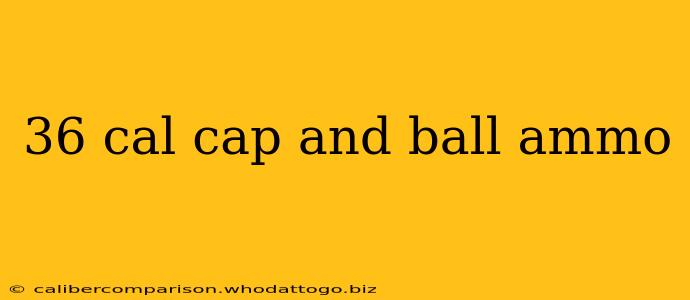The .36 caliber cap and ball revolver is a piece of American history, romanticized in the Wild West and still enjoyed by enthusiasts today. Understanding its ammunition, however, requires delving into the nuances of black powder cartridges and their modern counterparts. This guide provides a comprehensive overview of .36 caliber cap and ball ammo, covering its history, components, loading process, safety precautions, and sourcing.
A Blast from the Past: The History of .36 Caliber Cap and Ball
The .36 caliber emerged as a popular cartridge size in the mid-19th century, coinciding with the rise of percussion cap revolvers. These revolvers, unlike their flintlock predecessors, used a small percussion cap to ignite the black powder charge, offering a significant improvement in reliability and speed of firing. The .36 caliber was a common choice for these revolrencies due to its balance between power and practicality. It was used extensively in civilian life, law enforcement, and, notably, during the American Civil War. Many iconic revolvers, including those made by Colt and Remington, were chambered in .36 caliber.
Understanding the Components of .36 Caliber Cap and Ball Ammo
Cap and ball ammunition is a distinct system compared to modern cartridges. It relies on several key components working in concert:
-
The Percussion Cap: A small copper cap containing a sensitive explosive compound. When struck by the hammer, the cap ignites the black powder charge. Different manufacturers offer varying qualities, with some being more reliable than others. Finding a consistent, high-quality cap is essential for reliable firing.
-
The Black Powder Charge: This is the propellant that drives the bullet. Black powder is a relatively slow-burning propellant, giving cap and ball revolvers their characteristic slow, deliberate firing cycle. Choosing the correct amount of powder is crucial for optimal performance and safety. Too little powder leads to weak charges, while excessive powder can damage the firearm.
-
The Lead Ball: The projectile itself. These are typically round lead balls, cast to fit snugly within the cylinder's chambers. While round balls were standard, there were also conical bullets available for improved accuracy. Size consistency is crucial—inconsistent ball sizes can lead to misfires or damage.
Loading .36 Caliber Cap and Ball Ammo: A Step-by-Step Guide
Loading a cap and ball revolver requires care and precision. Improper loading practices can lead to dangerous misfires or malfunctions. Here's a general procedure (always consult your specific firearm's manual for detailed instructions):
-
Ensure the firearm is unloaded and the cylinder is open. Double-check to ensure no ammunition remains in the firearm.
-
Place the correct amount of black powder into each chamber. Use a powder measure for consistency.
-
Seat a lead ball into each chamber. Use a ball starter to ensure a proper fit.
-
Close the cylinder.
-
Place a percussion cap onto each nipple. Be careful not to damage the cap during placement.
-
Carefully cock the hammer.
-
Fire the revolver. Remember to observe proper firearm safety rules at all times.
Safety First: Essential Precautions for Handling .36 Caliber Cap and Ball Ammo
Safety should always be the utmost priority when handling black powder firearms. Here are some key safety precautions to follow:
-
Never point the firearm at anything you do not intend to shoot.
-
Always wear appropriate eye and ear protection.
-
Store black powder and ammunition separately and in a cool, dry place. Never store it near flammable materials.
-
Thoroughly clean the firearm after each use. Black powder residue is corrosive and needs to be cleaned to prevent damage to the firearm.
-
Be aware of the dangers of static electricity. Static discharge can ignite black powder.
Sourcing .36 Caliber Cap and Ball Ammo and Components
Finding supplies for .36 caliber cap and ball ammo may require some research. Many online retailers specialize in black powder supplies and components. Local gun shops may also carry these items, but availability can vary. Remember to check local and state laws regarding the purchase and possession of black powder and firearms before purchasing any materials.
Conclusion: A Timeless Cartridge
The .36 caliber cap and ball revolver holds a significant place in history and continues to fascinate enthusiasts today. Understanding its ammunition, loading procedures, and safety requirements is critical for safe and enjoyable shooting. By adhering to proper safety protocols and utilizing quality components, you can experience the unique charm and historical significance of this classic firearm and its ammunition.

